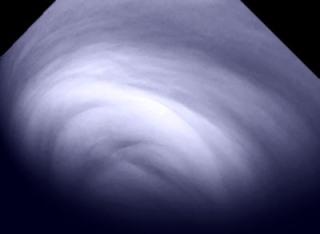
This false-colour ultraviolet image of the south pole of Venus was obtained by the Venus Monitoring Camera on board ESA’s Venus Express on 25 February 2008. An ESA photo
PARIS (BNS): A team of international scientists has solved the mystery behind the high-altitude sulphur dioxide layer detected in the atmosphere of Venus in 2008.
And the result, they believe, could not only tell more about Venus, but also indicate the potential consequences of injecting our own planet’s atmosphere with sulphur droplets to mitigate climate change.
Venus is blanketed by sulphuric acid clouds. These clouds form at altitudes of 50-70 km when sulphur dioxide from volcanoes combines with water vapour to make sulphuric acid droplets.
Any remaining sulphur dioxide should be destroyed rapidly by the intense solar radiation above 70 km.
However, the detection of sulphur dioxide layer at an altitude of 90-110 km in Venus’ atmosphere by European Space Agency’s Venus Express in 2008 came as a surprise discovery for the scientists.
Now, computer simulations by Xi Zhang, California Institute of Technology, USA, and colleagues from America, France and Taiwan show that some sulphuric acid droplets may evaporate at high altitude, freeing gaseous sulphuric acid that is then broken apart by sunlight, releasing sulphur dioxide gas.
“We had not expected the high-altitude sulphur layer, but now we can explain our measurements,” said Håkan Svedhem, ESA’s Venus Express Project Scientist. “However, the new findings also mean that the atmospheric sulphur cycle is more complicated than we thought,” the researcher said.
While the new findings give insight about Venus, they may also come as a warning against experimenting with our own planet Earth.
A recent suggestion by Nobel prize winner Paul Crutzen to inject artificially large quantities of sulphur dioxide into Earth’s atmosphere at around 20 km to counteract global warming resulting from increased greenhouse gases and thereby to cool the planet, may not be as successful as actually thought.
The proposal stems from observations of powerful volcanic eruptions, particularly the 1991 eruption of Mount Pinatubo in the Philippines that shot sulphur dioxide up into Earth’s atmosphere. Reaching 20 km in altitude, the gas formed small droplets of concentrated sulphuric acid, like those found in Venus’ clouds, which then spread around Earth.
The droplets created a haze layer that reflected some of the Sun’s rays back into space, cooling the whole planet by about 0.5°C.
However, the new work on the evaporation of sulphuric acid on Venus suggests that such attempts at cooling our planet may not be as successful as first thought, because we do not know how quickly the initially protective haze will be converted back into gaseous sulphuric acid: this is transparent and so allows all the Sun’s rays through.
“We must study in great detail the potential consequences of such an artificial sulphur layer in the atmosphere of Earth,” said Jean-Loup Bertaux, associated in the Venus Express project.
“Venus has an enormous layer of such droplets, so anything that we learn about those clouds is likely to be relevant to any geo-engineering of our own planet,” the scientist said.
 Previous Article
Previous Article Next Article
Next Article














The Indian Air Force, in its flight trials evaluation report submitted before the Defence Ministry l..
view articleAn insight into the Medium Multi-Role Combat Aircraft competition...
view articleSky enthusiasts can now spot the International Space Station (ISS) commanded by Indian-American astr..
view article